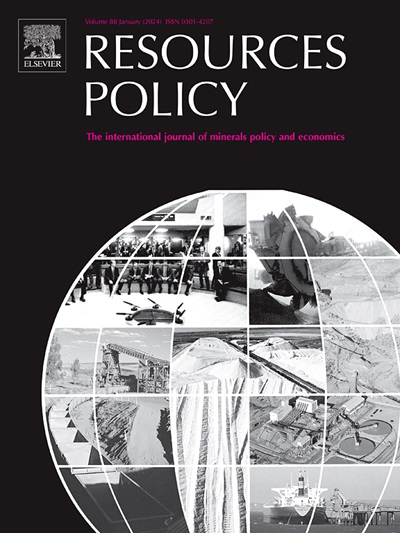能源转型背景下的全球铜需求预测
IF 10.2
2区 经济学
0 ENVIRONMENTAL STUDIES
引用次数: 0
摘要
由于铜在节能应用中的关键作用,可再生能源技术和电动汽车的广泛采用推动了能源转型,对全球铜需求产生了重大影响。本研究采用自回归分布滞后(ARDL)模型预测到2030年的全球铜需求,纳入了人均国内生产总值(GDP)、铜价和铝价等关键变量作为替代。该分析对铜消费数据进行了调整,以考虑风能、太阳能系统和电动汽车的贡献,突显出它们对需求的影响越来越大。结果表明,国内生产总值增长仍然是铜需求的主要驱动力,国内生产总值的年度变化与需求波动之间存在很强的相关性。铜需求对价格变化的反应缓慢,存在明显的滞后效应。虽然铝是铜的主要替代品,但其在关键应用中的有限性能凸显了铜在能源相关技术中的持续主导地位。调整后的模型显示,传统的计量经济学方法可能低估了清洁能源技术的影响,在不同的能源转型情景下,预计到2030年铜需求将大幅增加。这些发现强调了将新兴趋势整合到预测模型中的重要性,以指导政策制定者和行业利益相关者应对供应限制、市场波动和可持续性挑战。本文章由计算机程序翻译,如有差异,请以英文原文为准。
Projection of global copper demand in the context of energy transition
The energy transition, driven by the widespread adoption of renewable energy technologies and electric vehicles, is significantly influencing global copper demand due to copper's critical role in energy-efficient applications. This study employs an autoregressive distributed lag (ARDL) model to project global copper demand through 2030, incorporating key variables such as gross domestic product (GDP) per capita, copper prices, and aluminum prices as a substitute. The analysis adjusts copper consumption data to account for the contributions of wind and solar energy systems and electric vehicles, highlighting their growing influence on demand. Results show that GDP growth remains the primary driver of copper demand, with a strong correlation between annual changes in GDP and demand fluctuations. Copper demand demonstrates a slow response to price variations, with significant lagged effects. While aluminum serves as the primary substitute for copper, its limited performance in critical applications underscores copper's continued dominance in energy-related technologies. The adjusted model reveals that traditional econometric approaches may underestimate the impact of clean energy technologies, projecting substantial increases in copper demand by 2030 under different energy transition scenarios. These findings highlight the importance of integrating emerging trends into projection models to guide policymakers and industry stakeholders in addressing supply constraints, market volatility, and sustainability challenges.
求助全文
通过发布文献求助,成功后即可免费获取论文全文。
去求助
来源期刊

Resources Policy
ENVIRONMENTAL STUDIES-
CiteScore
13.40
自引率
23.50%
发文量
602
审稿时长
69 days
期刊介绍:
Resources Policy is an international journal focused on the economics and policy aspects of mineral and fossil fuel extraction, production, and utilization. It targets individuals in academia, government, and industry. The journal seeks original research submissions analyzing public policy, economics, social science, geography, and finance in the fields of mining, non-fuel minerals, energy minerals, fossil fuels, and metals. Mineral economics topics covered include mineral market analysis, price analysis, project evaluation, mining and sustainable development, mineral resource rents, resource curse, mineral wealth and corruption, mineral taxation and regulation, strategic minerals and their supply, and the impact of mineral development on local communities and indigenous populations. The journal specifically excludes papers with agriculture, forestry, or fisheries as their primary focus.
 求助内容:
求助内容: 应助结果提醒方式:
应助结果提醒方式:


